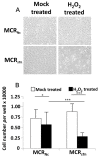Expression of sialyl-Tn sugar antigen in bladder cancer cells affects response to Bacillus Calmette Guérin (BCG) and to oxidative damage
- PMID: 28903359
- PMCID: PMC5589598
- DOI: 10.18632/oncotarget.17138
Expression of sialyl-Tn sugar antigen in bladder cancer cells affects response to Bacillus Calmette Guérin (BCG) and to oxidative damage
Abstract
The sialyl-Tn (sTn) antigen is an O-linked carbohydrate chain aberrantly expressed in bladder cancer (BC), whose biosynthesis is mainly controlled by the sialyltransferase ST6GALNAC1. Treatment with Bacillus Calmette-Guérin (BCG) is the most effective adjuvant immunotherapy for superficial BC but one third of the patients fail to respond. A poorly understood correlation between the expression of sTn and BC patient's response to BCG was previously observed. By analyzing tumor tissues, we showed that patients with high ST6GALNAC1 and IL-6 mRNA expression were BCG responders. To investigate the role of sTn in BC cell biology and BCG response, we established the cell lines MCRsTn and MCRNc by retroviral transduction of the BC cell line MCR with the ST6GALNAC1 cDNA or with an empty vector, respectively. Compared with MCRNc, BCG-stimulated MCRsTn secreted higher levels of IL-6 and IL-8 and their secretome induced a stronger IL-6, IL-1β, and TNFα secretion by macrophages, suggesting the induction of a stronger inflammatory response. Transcriptomic analysis of MCRNc and MCRsTn revealed that ST6GALNAC1/sTn expression modulates hundreds of genes towards a putative more malignant phenotype and down-regulates several genes maintaining genomic stability. Consistently, MCRsTn cells displayed higher H2O2 sensitivity. In MCRsTn,, BCG challenge induced an increased expression of several regulatory non coding RNA genes. These results indicate that the expression of ST6GALNAC1/sTn improves the response to BCG therapy by inducing a stronger macrophage response and alters gene expression towards malignancy and genomic instability, increasing the sensitivity of BC cells to the oxidizing agents released by BCG.
Keywords: Bacillus Calmette-Guérin; ST6GALNAC1 sialyltransferase; bladder cancer; glycosylation; sialyl-Tn antigen.
Conflict of interest statement
CONFLICTS OF INTEREST The Authors declare that there are no conflicts of interests.
Figures





Similar articles
-
Oxidative damage and response to Bacillus Calmette-Guérin in bladder cancer cells expressing sialyltransferase ST3GAL1.BMC Cancer. 2018 Feb 17;18(1):198. doi: 10.1186/s12885-018-4107-1. BMC Cancer. 2018. PMID: 29454317 Free PMC article.
-
The androgen receptor controls expression of the cancer-associated sTn antigen and cell adhesion through induction of ST6GalNAc1 in prostate cancer.Oncotarget. 2015 Oct 27;6(33):34358-74. doi: 10.18632/oncotarget.6024. Oncotarget. 2015. PMID: 26452038 Free PMC article.
-
Intravesical instillation therapy with bacillus Calmette-Guérin for superficial bladder cancer: study of the mechanism of bacillus Calmette-Guérin immunotherapy.Int J Urol. 2007 Feb;14(2):140-6. doi: 10.1111/j.1442-2042.2007.01696.x. Int J Urol. 2007. PMID: 17302571
-
Bacillus Calmette-Guérin immunotherapy for genitourinary cancer.BJU Int. 2013 Aug;112(3):288-97. doi: 10.1111/j.1464-410X.2012.11754.x. Epub 2013 Mar 20. BJU Int. 2013. PMID: 23517232 Review.
-
The Role of Sialyl-Tn in Cancer.Int J Mol Sci. 2016 Feb 24;17(3):275. doi: 10.3390/ijms17030275. Int J Mol Sci. 2016. PMID: 26927062 Free PMC article. Review.
Cited by
-
A Systematic Review on the Implications of O-linked Glycan Branching and Truncating Enzymes on Cancer Progression and Metastasis.Cells. 2020 Feb 14;9(2):446. doi: 10.3390/cells9020446. Cells. 2020. PMID: 32075174 Free PMC article.
-
POFUT1 mRNA expression as an independent prognostic parameter in muscle-invasive bladder cancer.Transl Oncol. 2021 Jan;14(1):100900. doi: 10.1016/j.tranon.2020.100900. Epub 2020 Oct 21. Transl Oncol. 2021. PMID: 33099185 Free PMC article.
-
Contrasting Metabolic Insufficiency in Aging and Dementia.Aging Dis. 2021 Jul 1;12(4):1081-1096. doi: 10.14336/AD.2021.0104. eCollection 2021 Jul. Aging Dis. 2021. PMID: 34221551 Free PMC article. Review.
-
Aberrantly Glycosylated GLUT1 as a Poor Prognosis Marker in Aggressive Bladder Cancer.Int J Mol Sci. 2024 Mar 19;25(6):3462. doi: 10.3390/ijms25063462. Int J Mol Sci. 2024. PMID: 38542435 Free PMC article.
-
L1CAM as an E-selectin Ligand in Colon Cancer.Int J Mol Sci. 2020 Nov 5;21(21):8286. doi: 10.3390/ijms21218286. Int J Mol Sci. 2020. PMID: 33167483 Free PMC article.
References
-
- Videira PA, Calais FM, Correia M, Ligeiro D, Crespo HJ, Calais F, Trindade H. Efficacy of bacille Calmette-Guérin immunotherapy predicted by expression of antigen-presenting molecules and chemokines. Urology. 2009;74:944–50. - PubMed
-
- Carretero R, Cabrera T, Gil H, Saenz-Lopez P, Maleno I, Aptsiauri N, Cozar JM, Garrido F. Bacillus Calmette-Guerin immunotherapy of bladder cancer induces selection of human leukocyte antigen class I-deficient tumor cells. Int J Cancer. 2011;129:839–46. - PubMed
-
- Dall’Olio F, Malagolini N, Trinchera M, Chiricolo M. Mechanisms of cancer-associated glycosylation changes. Front Biosci (Landmark Ed) 2012;17:670–99. - PubMed
LinkOut - more resources
Full Text Sources
Other Literature Sources

